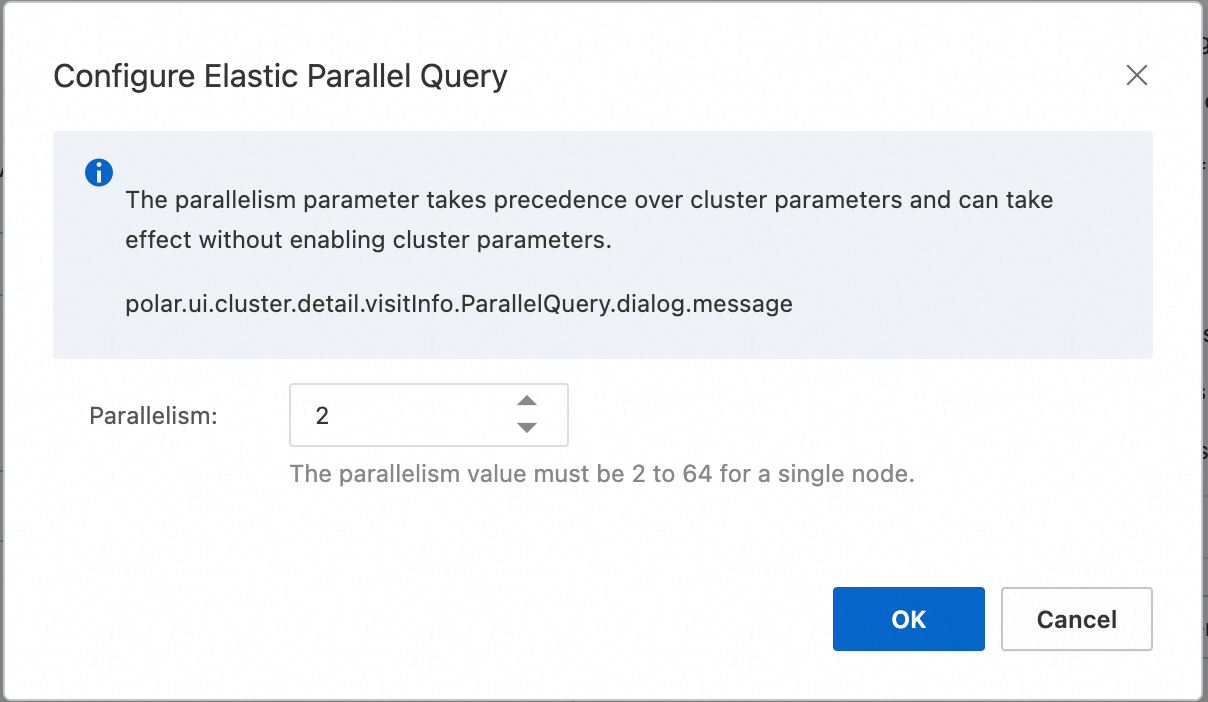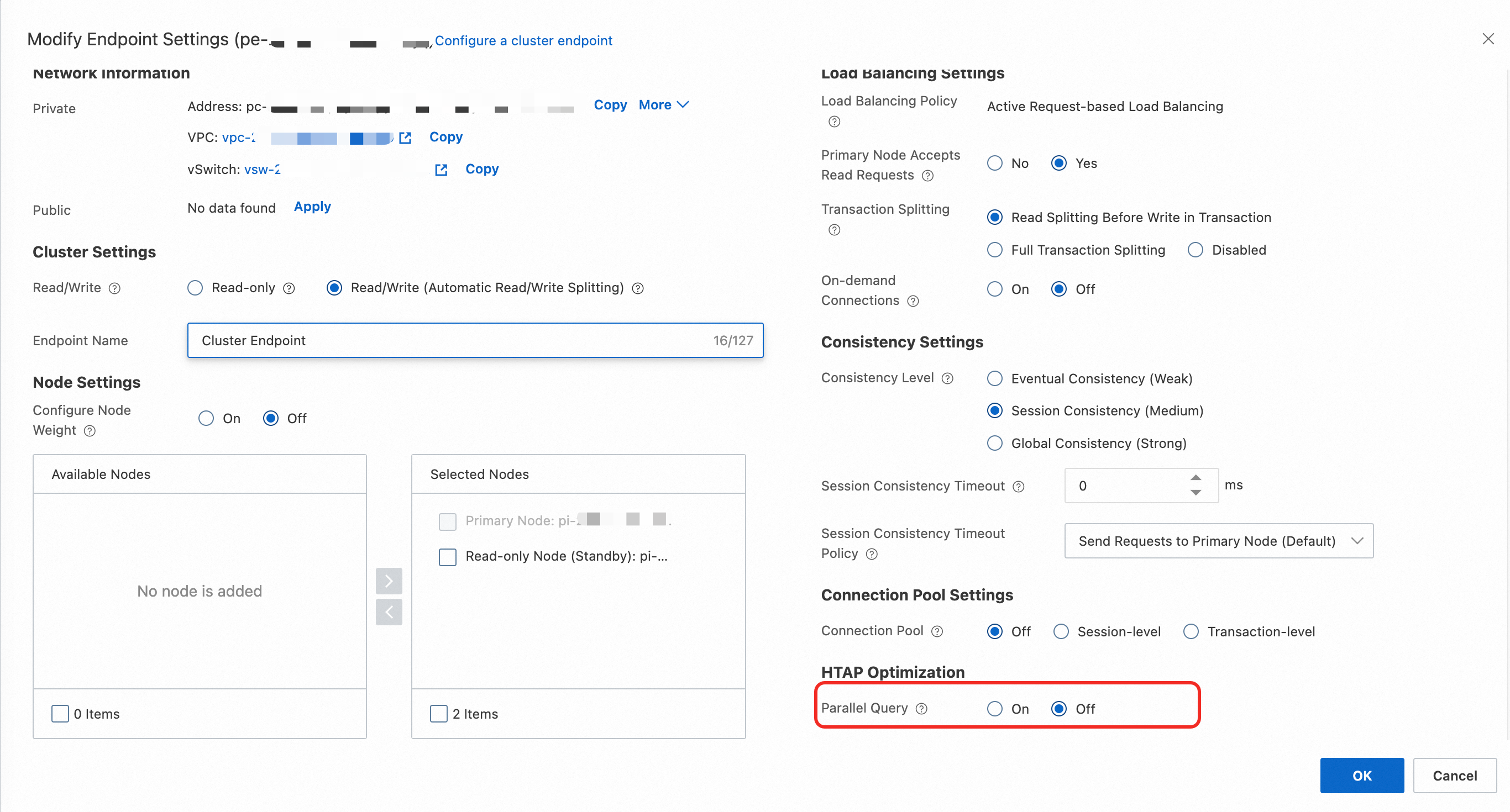This topic describes how to use the Elastic Parallel Query (ePQ) feature.
Usage notes
Make sure the version of your cluster is supported by the ePQ feature.
Single-node elastic parallel query:
Database engine: 8.0.1 whose revision version is 8.0.1.0.5 or later.
Database edition: Enterprise Edition.
Single-node elastic parallel query:
Database engine: 8.0.2 whose revision version is 8.0.2.1.4.1 or later.
Database edition: Enterprise Edition.
Multi-node elastic parallel query:
Database engine: 8.0.2 whose revision version is 8.0.2.2.6 or later.
Database edition: Enterprise Edition.
Make sure that you are aware of the limits and compatibility issues of the ePQ feature. For more information, see Limits and compatibility issues.
Both read-only nodes and the primary node support the ePQ feature. ePQ is disabled on the primary node by default. You can enable this feature based on your requirements. For more information, see Adaptive DOP settings.
Enable or disable ePQ
Enable ePQ
Log on to the . In the Database Connections section of the Basic Information page, select an endpoint and click Configure. In the Modify Endpoint Settings dialog, select On for Parallel Query and configure the value of Parallelism.
Recommended settings and description
Parallelism the maximum number of worker threads that can run simultaneously in a single compute node for a single query. The maximum number of worker threads that can run simultaneously in a single query is the product of the degree of parallelism (DOP) and the number of nodes.
Increase the value of Parallelism in small increments. We recommend that you do not use a value that exceeds a quarter of the total number of CPU cores.. For example, you can set the value of Parallelism to 2. You can check the CPU utilization the next day. If the CPU utilization is low, increase the value. If the CPU utilization is high, do not increase the value.
ePQ is enabled only for connections that are established after you turn on the feature.
When you enable ePQ, set the
innodb_adaptive_hash_indexparameter to OFF.NoteIf the
innodb_adaptive_hash_indexparameter is set to ON, the performance of parallel query is degraded.The default value of the thread_pool_enabled parameter is OFF. If you have not modified this parameter, you can ignore this setting.
DOP can be configured in the console or by using the cluster parameter:
You can configure DOP in the console or by using the
max_parallel_degreeparameter. The settings in the console prevail. We recommend that you use the console to enable ePQ.If you do not enable ePQ in the console but set
max_parallel_degreeto a value greater than 0, ePQ is enabled.NoteThe
max_parallel_degreeparameter specifies the maximum DOP for an individual query, which is the maximum number of workers that are used to run the query in parallel. For more information, see Configuration parameters.
Disable ePQ
Log on to the . In the Database Connections section of the Basic Information page, select an endpoint and click Configure. In the Modify Endpoint Settings dialog, select Off for Parallel Query.
Note:
ePQ is disabled only for connections that are established after you turn off the feature.
After you disable ePQ in the console, confirm that the
max_parallel_degreeparameter is set to 0 to ensure that ePQ is completely disabled.NoteThe
max_parallel_degreeparameter specifies the maximum DOP for an individual query, which is the maximum number of workers that are used to run the query in parallel. For more information, see Configuration parameters.
Configure ePQ
You can configure a set of parameters to manage the ePQ feature. The following table lists some key parameters. For more information, see DOP policies.
Type | Description |
Adaptive DOP settings | You can set the DOP for a single query by configuring the
|
Specify whether the optimizer can enable ePQ | PolarDB provides two thresholds to specify whether the optimizer can enable the elastic parallel query feature. If an SQL statement meets one of the following conditions, the optimizer enables the elastic parallel query feature.
|
Specify whether to enable multi-node ePQ | The PolarDB two thresholds to specify whether to enable multi-node elastic parallel query. If an SQL statement meets one of the following conditions, multi-node elastic parallel query can be used.
|
Use hints to control ePQ
You can optimize an individual SQL statement by using hints to specify whether the optimizer enables ePQ. You can also use hints to configure DOP and the table that needs to enable ePQ. For example, if ePQ is disabled by the system, you can use hints to accelerate a slow SQL query that is frequently executed. For more information, see Parallel hints.
Limits and compatibility issues
Limits
PolarDB continuously improves the parallel query feature. This feature cannot improve performance in the following situations:
Queries on
non-Innodbtables.Queries that use full-text indexes.
Stored procedures, which must be executed by the leader.Tables that are scanned by using
INDEX-MERGEjoins.Queries in serializable transactions.
INSERT ... SELECT and REPLACE ... SELECTstatements in transactions when the isolation level isRepeatable Read.
Compatibility issues
The number of error messages may increase.
Assume that you use serial execution for statements and error messages occur. If you use parallel execution for the same statements, more error messages may be returned.
Precision issues may occur.
For serial execution, no intermediate results need to be stored. For parallel execution, you may need to store intermediate results. If the intermediate results are floating-point numbers, the precision of the floating-point numbers may be different from that of parallel execution. This may result in differences in the results of parallel execution and serial execution.
The size of network packets or intermediate results exceeds the upper limit that is specified by the
max_allowed_packetparameter.For serial execution, no intermediate results are produced. For parallel execution, intermediate results may be produced. If the size of the intermediate results exceeds the upper limit that is specified by the
max_allowed_packetparameter, an error message may be returned. To resolve this issue, you can increase the value of themax_allowed_packetparameter. For more information about how to modify parameters, see Specify cluster and node parameters.The order of the result sets for parallel execution may be different from that for serial execution.
If the
SELECT ... LIMIT nstatement that does not contain theORDER BYkeyword is executed in parallel, the order of the returned result sets may be inconsistent with the execution order. Multiple workers are executed simultaneously. Therefore, the execution speed of the workers is uncertain during each execution. After the leader retrieves enough data, the final results are returned. As a result, the order of the returned result sets may be inconsistent with the execution order.The number of data records that have row locks is increased.
If the
SELECT ... FROM ... FOR SHAREstatement is executed in parallel, InnoDB locks each row of data that is accessed. Therefore, the number of records that have row locks may be more than that in non-parallel execution cases. This phenomenon is normal in parallel execution cases.



